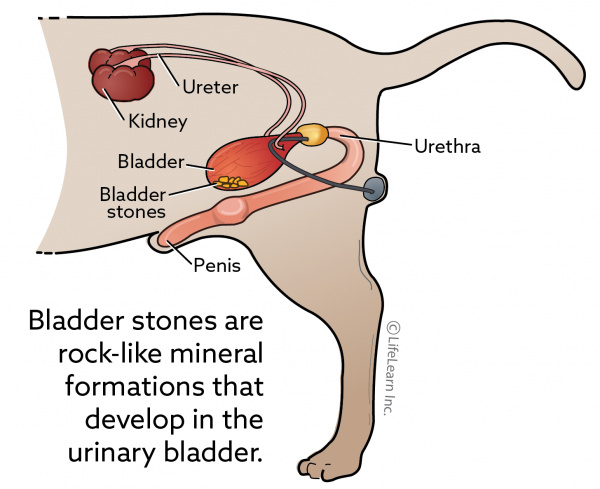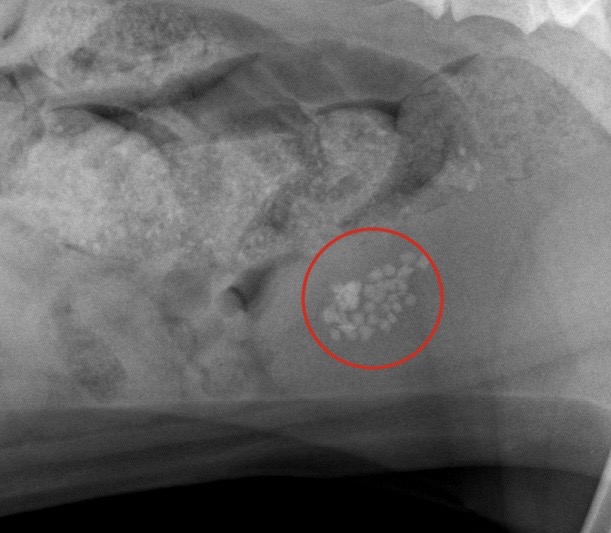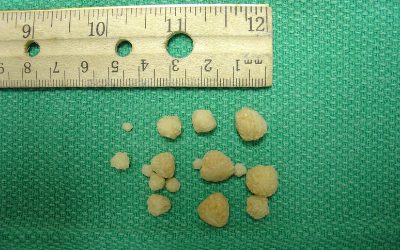What are bladder stones?
Bladder stones (uroliths or cystic calculi) are rock-like formations of minerals that develop in the urinary bladder. There may be a large, single stone or a collection of stones that range in size from sand-like grains to gravel. It is common for a mixture of both small and large stones to be present.

What other kinds of stones are there?
Gall stones form in the gall bladder and contain bile salts. Kidney stones are mineralized formations that develop in the kidney. Neither of these are directly related to bladder stones. Even though the kidneys and urinary bladder are both part of the urinary system, the development of kidney stones is not usually linked to the development of bladder stones. All stones form as a result of disease or inflammation in the affected structure.
What are the clinical signs of bladder stones?
The most common signs that a dog has bladder stones are hematuria (blood in the urine) and dysuria (straining to urinate). Hematuria occurs because the stones rub against the bladder wall, irritating and damaging the tissue and causing bleeding. Dysuria may result from inflammation and swelling of the bladder wall or the urethra (the tube that transports the urine from the bladder to the exterior of the body), from muscle spasms, or from a physical obstruction of urine flow. Veterinarians assume the condition is painful because people with bladder stones experience pain, and because many clients remark about how much better and more active their dog becomes following surgical removal of bladder stones.
Large stones may act almost like a valve or stopcock, causing an intermittent or partial obstruction at the neck of the bladder, the point where the bladder attaches to the urethra. Small stones may flow with the urine into the urethra where they can become lodged and cause an obstruction. If an obstruction occurs, the bladder cannot be emptied fully; if the obstruction is complete, the dog will not be able to urinate at all. If the obstruction is not relieved, the bladder may rupture.
A complete obstruction is potentially life-threatening and requires immediate emergency treatment. A urinary obstruction will usually be recognized in a dog that is straining to urinate without producing any urine, or is only producing small squirts of urine.
How did my dog get bladder stones?
There are several theories of how bladder stones form. The most commonly accepted theory is called the Precipitation-Crystallization Theory. This theory states that one or more stone-forming crystalline compounds are present in elevated levels in the urine. This may be due to dietary factors or due to some previous disease in the bladder, especially a bacterial infection. Sometimes the condition may be due to a problem with the body’s metabolism.
When the amount of this compound exceeds a threshold level, the urine becomes saturated and cannot hold any more of the compound. The saturation level depends on the specific minerals that are present and the pH (acidity) of the urine. These excess compounds precipitate out of solution and form tiny crystals. The sharp crystals irritate the bladder lining, causing a production of mucus. The crystals and mucus stick together, forming clusters that gradually enlarge and harden into stones.
How quickly can bladder stones form?
Bladder stones can develop within a few weeks, or they may take months to form. Speed of growth will usually depend on the quantity of crystalline material present and the degree of infection present. Although it may take months for a large stone to grow, some sizable stones have been documented to form in as little as two weeks.
How are bladder stones diagnosed?
The signs of bladder stones are similar to those of an uncomplicated bladder infection or cystitis. Most dogs that have a bladder infection do not have bladder stones. Therefore, a conclusion of bladder stones is not based only on these common clinical signs.
Some bladder stones can be palpated (felt with the fingers) through the abdominal wall. However, failure to palpate them does not rule them out. Some stones are too small to be felt in this manner, or the bladder may be too inflamed and painful to allow palpation.
Most bladder stones are visible on radiographs (X-rays) or an ultrasonic bladder examination. Some bladder stones are radiolucent, or are not visible on radiographs because their mineral composition does not reflect X-ray beams. They can be detected by an ultrasound examination or with a radiographic contrast study, a special X-ray technique that uses dye or contrast material to outline the stones within the bladder. Therefore, one or more of these diagnostic imaging techniques should be performed on dogs that show signs of abdominal pain or have recurrent episodes of cystitis.
How are bladder stones treated?
In general, there are three main treatment options for bladder stones: 1) surgical removal; 2) non-surgical removal by urohydropropulsion, and 3) dietary dissolution. The specific treatment that is recommended for your dog will depend on the type of stone that is present. Your veterinarian will discuss the pros and cons of each treatment option with you in more detail, based on your dog’s individual circumstances.

Surgical removal of bladder stones. This is often the quickest way of treating bladder stones; however, it may not be the best option for patients that have other health concerns, or in whom general anesthesia could be risky. With this option, the stones are removed via cystotomy; a surgical procedure to access and open the bladder so that the stones can be removed. This surgery is routinely performed by many veterinarians and dogs usually make a rapid post-operative recovery. If the stones have obstructed the urethra, such that the dog is unable to urinate, an emergency procedure must be performed IMMEDIATELY to save the dog’s life.
Urohydropropulsion. If the bladder stones are very small it may be possible to pass a special catheter into the bladder and then flush the stones out, using a non-surgical technique called urohydropropulsion. In some cases, this procedure may be performed with the dog under heavy sedation, although general anesthesia is often necessary. If your veterinarian has a cystoscope, small stones in the bladder can sometimes be removed with this instrument, therefore avoiding surgical procedure to open the bladder.
Either of these non-surgical procedures may be used to obtain a sample stone for analysis so that your veterinarian can determine if dietary dissolution is feasible.
Dietary dissolution. In some cases, bladder stones can be dissolved by feeding your dog a special diet that is formulated to dissolve bladder stone(s). This diet will be tailored to the specific type of stone that is present. The advantage of this option is that it avoids surgery. It can be a very good choice for some dogs. However, it has three disadvantages:
- It is not successful for all types of stones. Stone analysis is necessary to determine if it is the type of stone that can be successfully dissolved. This may not be possible in all cases. Sometimes, your veterinarian will make an educated guess on the type of stone, based on the radiographic (X-ray) appearance and the results of a urinalysis.
- It is slow. It may take several weeks or a few months to dissolve a large stone, so your dog may continue to have hematuria, dysuria, and recurrent infections during that time. The risk of urethral obstruction remains high during this time.
- Not all dogs will eat the special diet. These diets will not work unless they are fed exclusively. This means that NO TREATS or supplements can be given to your dog while it is on the special diet.
Are there any other treatment options?
In some selected referral centers, a fourth option may be available to treat bladder stones. This option is ultrasonic dissolution, a technique in which high frequency ultrasound waves are used to disrupt or break the stones into tiny particles that can then be flushed out of the bladder. It has the advantage of immediate removal of the offending stones without the need for surgery. Your veterinarian will discuss this treatment option with you if it is available in your area.
Can bladder stones be prevented?
Prevention is possible in some cases, depending on the chemical composition of the stones. There are at least five types of bladder stones common in dogs.

Whenever possible, bladder stones (either those that are removed surgically or those small enough to be passed in the urine), should be analyzed for their chemical composition. This will permit your veterinarian to determine if a special diet will be helpful in preventing recurrence. If the stones formed because of a bacterial infection, it is recommended that periodic urinalyses and urine cultures be performed to detect sub-clinical recurrences and determine if antibiotics should be prescribed. Periodic bladder X-rays or ultrasounds may be helpful in some cases to determine if bladder stones are recurring.
Early recognition may allow your veterinarian to adjust your dog’s diet or medications before your pet requires surgery.
© Copyright 2019 LifeLearn Inc. Used and/or modified with permission under license.






